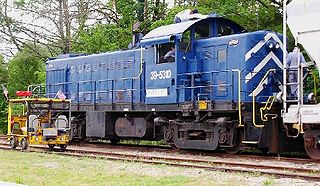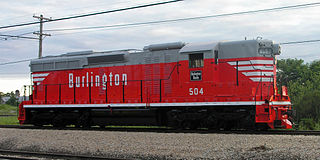
A switcher locomotive, shunter locomotive, or shifter locomotive is a locomotive used for maneuvering railway vehicles over short distances. Switchers do not usually move trains over long distances, instead they typically assemble trains in order for another locomotive to take over. Switchers often operate in a railyard or make short transfer runs. They may serve as the primary motive power on short branch lines or switching and terminal railroads.

A diesel locomotive is a type of railway locomotive in which the power source is a diesel engine. Several types of diesel locomotives have been developed, differing mainly in the means by which mechanical power is conveyed to the driving wheels. The most common are diesel-electric locomotives and diesel-hydraulic.

Montreal Locomotive Works (MLW) was a Canadian railway locomotive manufacturer that existed under several names from 1883 to 1985, producing both steam and diesel locomotives. For many years it was a subsidiary of the American Locomotive Company. MLW's headquarters and manufacturing facilities were in Montreal, Quebec.

The EMD BL2 is a model of diesel-electric locomotive built by General Motors Electro-Motive Division (EMD). A total of 58 units were built between 1947 and 1949. The BL2 was not very successful, as it was unreliable and occupied a gap between carbody and hood units, which resulted in it suffering from the drawbacks of both designs. However, lessons learned from the BL2 were incorporated into EMD's next design, the GP7.

The EMC-TA was a model of diesel locomotive produced for the Chicago, Rock Island and Pacific Railroad by the Electro-Motive Corporation in 1937. The original six Rock Island Rockets streamliners were three- or four-car stainless-steel semi-articulated trainsets built by Budd Company, powered by six identical locomotives, #601-606. The locomotives were classified as model TA—the T indicating Twelve hundred hp (890 kW), the A indicating an A unit. The Rock Island Line was EMC's only customer for the TA locomotive model.

A hood unit, in North American railroad terminology, is a body style for diesel and electric locomotives where the body is less than full-width for most of its length and walkways are on the outside. In contrast, a cab unit has a full-width carbody for the length of the locomotive and walkways inside. A hood unit has sufficient visibility to be operated in both directions from a single cab. Also, the locomotive frame is the main load-bearing member, allowing the hood to be non-structural and easily opened or even removed for maintenance.

A road switcher locomotive is a type of railroad locomotive designed to both haul railcars in mainline service and shunt them in railroad yards. Both type and term are North American in origin, although similar types have been used elsewhere.

The EMD SD40-2 is a 3,000-horsepower (2,200 kW) C-C diesel-electric locomotive built by EMD from 1972 to 1989.

The EMD SD24 was a 2,400 hp (1,800 kW) six-axle (C-C) diesel-electric locomotive built by General Motors' Electro-Motive Division of La Grange, Illinois between July 1958 and March 1963. A total of 224 units were built for customers in the United States, comprising 179 regular, cab-equipped locomotives and 45 cabless B units. The latter were built solely for the Union Pacific Railroad.

The EMD GP7 is a four-axle (B-B) diesel-electric locomotive built by General Motors Electro-Motive Division and General Motors Diesel between October 1949 and May 1954.

The EMD GP38-2 is an American four-axle diesel-electric locomotive built by General Motors, Electro-Motive Division. Part of the EMD Dash 2 line, the GP38-2 was an upgraded version of the earlier GP38. Power is provided by an EMD 645E 16-cylinder engine, which generates 2,000 horsepower.

Amtrak has used a variety of paint schemes (liveries) on its rolling stock since taking over intercity passenger rail service in the United States in 1971. A series of seven schemes termed Phases, first introduced in 1972, have seen the widest use. Phases primarily use geometric arrangements of red, white, and blue—the national colors of the United States—part of Amtrak's patriotic visual identity.

The British Rail Class 17 was a class of 117 Bo-Bo diesel-electric locomotives built 1962–1965 by Clayton Equipment Company and their sub-contractor Beyer, Peacock & Co., on behalf of British Railways (BR).

The term cab forward locomotive refers to various rail and road vehicle designs that place the driver's compartment substantially farther towards the front than is common practice.

Steeplecab is railroad terminology for a style or design of electric locomotive; the term is rarely if ever used for other forms of power. The name originated in North America and has been used in Britain as well.

The long hood of a hood unit-style diesel locomotive is, as the name implies, the longer of the two hoods on a locomotive, particularly American-type freight locomotives.

The GE U30CG was a passenger-hauling diesel-electric locomotive built by GE Transportation Systems. It was a passenger variant of GE's U30C design purchased by the Atchison, Topeka and Santa Fe Railway. ATSF had purchased ten U28CG locomotives in 1966, and while these locomotives were satisfactory operationally, the railroad felt that their utilitarian appearance was unsuitable for its passenger trains. Desiring smooth-sided passenger power, the railroad ordered the first cowl units from both GE and GM-EMD. GE produced the U30CG to meet this requirement. It was mechanically identical to a U30C except that the bodywork was replaced with a full-width long hood with fluted stainless-steel panels, and a full-width rounded nose and slanted cab front were fitted.

A comfort cab is a design found on most modern North American diesel locomotives, and some export models. The broad nose occupies the entire width of the locomotive, and typically has an access door on the front of the nose.

The T class are a class of diesel locomotives built by Clyde Engineering, Granville for the Victorian Railways between 1955 and 1968.

The cab, crew compartment or driver's compartment of a locomotive, or a self-propelled rail vehicle, is the part housing the train driver, fireman or secondman, and the controls necessary for the locomotive or self-propelled rail vehicle's operation.






















